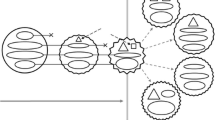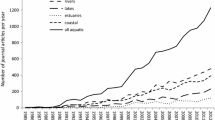Abstract
The importance of long-term environmental monitoring and research for detecting and understanding changes in ecosystems and human impacts on natural systems is widely acknowledged. Over the last decades, a number of critical components for successful long-term monitoring have been identified. One basic component is quality assurance/quality control protocols to ensure consistency and comparability of data. In Norway, the authorities require environmental monitoring of the impacts of the offshore petroleum industry on the Norwegian continental shelf, and in 1996, a large-scale regional environmental monitoring program was established. As a case study, we used a sub-set of data from this monitoring to explore concepts regarding best practices for long-term environmental monitoring. Specifically, we examined data from physical and chemical sediment samples and benthic macroinvertebrate assemblages from 11 stations from six sampling occasions during the period 1996–2011. Despite the established quality assessment and quality control protocols for this monitoring program, we identified several data challenges, such as missing values and outliers, discrepancies in variable and station names, changes in procedures without calibration, and different taxonomic resolution. Furthermore, we show that the use of different laboratories over time makes it difficult to draw conclusions with regard to some of the observed changes. We offer recommendations to facilitate comparison of data over time. We also present a new procedure to handle different taxonomic resolution, so valuable historical data is not discarded. These topics have a broader relevance and application than for our case study.








Similar content being viewed by others
References
Arrouays, D., Marchant, B. P., Saby, N. P. A., Meersmans, J., Orton, T. G., Martin, M. P., Bellamy, P. H., Lark, R. M., & Kibblewhite, M. (2012). Generic issues on broad-scale soil monitoring schemes: a review. Pedosphere, 22, 456–469.
Bakke, T., Green, A. M. V., & Iversen, P. E. (2011). Offshore environmental monitoring in Norway—regulations, results and developments. In K. Lee & J. Neff (Eds.), Produced water (pp. 481–491). NY: Springer (Chapter 25).
Bakke, T., Klungsøyr, J., & Sanni, S. (2013). Environmental impacts of produced water and drilling waste discharges from the Norwegian offshore petroleum industry. Marine Environmental Research, 92, 154–169.
Bennett, J. R., Sisson, D. S., Smol, J. P., Cumming, B. F., Possingham, H. P., & Buckley, Y. M. (2014). Optimizing taxonomic resolution and sampling effort to design cost-effective ecological models for environmental assessment. Journal of Applied Ecology, 51, 1722–1732.
Buss, D. F., Carlisle, D. M., Chon, T.-S., Culp, J., Harding, J. S., Keizer-Vlek, H. E., et al. (2015). Stream biomonitoring using macroinvertebrates around the globe: a comparison of large-scale programs. Environmental Monitoring and Assessment, 187, 4132. https://doi.org/10.1007/s10661-014-4132-8.
Cao, Y., & Hawkins, C. P. (2011). The comparability of bioassessments: a review of conceptual and methodological issues. Journal of the North American Benthological Society, 30(3), 680–701.
Cochrane, S., Palerud, R., Wasbotten, I. H., Larsen, L. H., & Mannvik, H. P. (2009). Offshore sediment survey of Region I, 2008. Akvaplan-niva report no. 4215-02. Akvaplan-niva, Tromsø. 314 pp.
Desaules, A. (2012). Measurement instability and temporal bias in chemical soil monitoring: sources and control measures. Environmental Monitoring and Assessment, 184, 487–502.
Ellingsen, K. E. (2001). Biodiversity of a continental shelf soft-sediment macrobenthos community. Marine Ecology Progress Series, 218, 1–15.
Ellingsen, K. E. (2002). Continental shelf soft-sediment benthic biodiversity in relation to environmental variability. Marine Ecology Progress Series, 232, 15–27.
Ellingsen, K. E., & Gray, J. S. (2002). Spatial patterns of benthic diversity: is there a latitudinal gradient along the Norwegian continental shelf? Journal of Animal Ecology, 71, 373–389.
Fontaine, A., Devillers, R., Peres-Neto, P. R., & Johnson, L. E. (2015). Delineating marine ecological units: a novel approach for deciding which taxonomic group to use and which taxonomic resolution to choose. Diversity and Distributions, 21, 1167–1180.
Frid, C. L. J., Harwood, K. G., Hall, S. J., & Hall, J. A. (2000). Long-term changes in the benthic communities on North Sea fishing grounds. ICES Journal of Marine Science, 57, 1303–1309.
Fölster, J., Johnson, R. K., Futter, M. N., & Wilander, A. (2014). The Swedish monitoring of surface waters: 50 years of adaptive monitoring. Ambio, 43, 3–18.
Gattuso, J.-P., Magnan, A., Billé, R., Cheung, W. W. L., Howes, E. L., Joos, F., et al. (2015). Contrasting futures for ocean and society from different anthropogenic CO2 emissions scenarios. Science, 349.
Gray, J. S., Clarke, K. R., Warwick, R. M., & Hobbs, G. (1990). Detection of initial effects of pollution on marine benthos: an example from the Ekofisk and Eldfisk oilfields, North Sea. Marine Ecology Progress Series, 66, 285–299.
Gray, J. S., Bakke, T., Beck, H. J., & Nilssen, I. (1999). Managing the environment effects of the Norwegian oil and gas industry: from conflict to consensus. Marine Pollution Bulletin, 38(7), 525–530.
Hewitt, J. E., & Thrush, S. F. (2007). Effective long-term ecological monitoring using spatially and temporally nested sampling. Environmental Monitoring and Assessment, 133, 295–307.
Hughes, B. (2014). Monitoring: garbage in yields garbage out. Fisheries, 39(6), 243–243. https://doi.org/10.1080/03632415.2014.915813.
Hughes, R. M., & Peck, D. V. (2008). Acquiring data for large aquatic resource surveys: the art of compromise among science, logistics, and reality. Journal of the North American Benthological Society, 27(4), 837–859.
Iversen, P. E., Green, A. M. V., Lind, M. J., Petersen, M. R. H., Bakke, T., Lichtenthaler, R., et al., (2011). Guidelines for offshore environmental monitoring: the petroleum sector on the Norwegian continental shelf. Climate and Pollution Agency. TA number 2849/2011. 49 pp.
Iversen, P. E. Lind, M. J., Ersvik, M., Rønning, I., Skaare, B. B., Green, A. M. V., et al., (2015). Guidelines for environmental monitoring of petroleum activities on the Norwegian continental shelf. The Norwegian Environment. Agency M-number M-300/2015. 60 pp. (In Norwegian).
Jensen, T., Gjøs, N., Nøland, S.-A., Oreld, F., Møskeland, T., Bakke, S. M., et al., (2000). Environmental monitoring 1999, Region I—Ekofisk. Technical report. Report no. 2000-3238. Det Norske Veritas & Sintef Applied Chemistry, Norway. 294 pp.
Kaiser, M. J., Clarke, K. R., Hinz, H., Austen, M. C. V., Somerfield, P. J., & Karakassis, I. (2006). Global analysis of response and recovery of benthic biota to fishing. Marine Ecology Progress Series, 311, 1–14.
Lindenmayer, D. B., Burns, E. L., Tennant, P., Dickman, C. R., Green, P. T., Keith, D. A., et al. (2015). Contemplating the future: acting now on long-term monitoring to answer 2050’s questions. Austral Ecology, 40, 213–224.
Lindenmayer, D. B., & Likens, G. E. (2010). Effective ecological monitoring. London: CSIRO Publishing 170 pp.
Little, R. J. A., & Rubin, D. B. (1987). Statistical analysis with missing data. New York: John Wiley and Sons.
Loraine, A. E., Blakley, I. C., Jagadeesan, S., Harper, J., Miller, G., & Firon, N. (2015). Analysis and visualization of RNA-Seq expression data using RStudio, Bioconductor, and Integrated Genome Browser. Methods in molecular biology (Clifton, N. J.), 1284, 481–501.
Mannvik, H. P., Pearson, T., Pettersen, A., & Lie Gabrielsen, K. (1997). Environmental monitoring survey Region I 1996. Main report. Akvaplan-niva report no. 411.96.996-1. Akvaplan-Niva, Tromsø. 246 pp.
Mannvik, H. P., Wasbotten, I. H., Cochrane, S., & Moldes-Anaya, A. (2012). Miljøundersøkelse Region I, 2011. Akvaplan-niva report no. 5339.02. Akvaplan-niva, Tromsø. 196 pp. (In Norwegian).
Mieszkowska, N., Sugden, H., Firth, L. B., & Hawkins, S. J. (2014). The role of sustained observations in tracking impacts of environmental change on marine biodiversity and ecosystems. Philosophical Transactions of the Royal Society A, 372, 20130339.
Nichols, J. D., & Williams, B. K. (2006). Monitoring for conservation. Trends in Ecology & Evolution, 21, 668–673.
Norwegian Oil and Gas (2013). Environmental report 2013. The Norwegian Oil and Gas Association. http://www.norskoljeoggass.no/en/Publica/Environmentalreports/Environmental-report-2013/.
Nøland, S. A., Gjøs, N., Bakke, S. M., & Oreld F. (2003). Environmental monitoring 2002, Region I—Ekofisk. Main report. Technical report. Report no. 2003-0338. Det Norske Veritas/Sintef, Norway. 316 pp.
Nøland, S. A., Bakke, S. M., Rustad, I., & Brinchmann, K. M. (2006). Environmental monitoring Region I, 2005. Main report. Report no. 2006-0187. Det Norske Veritas, Norway. 344 pp.
Olsgard, F., & Gray, J. S. (1995). A comprehensive analysis of the effects of offshore oil and gas exploration and production on the benthic communities of the Norwegian continental shelf. Marine Ecology Progress Series, 122, 277–306.
R Core Team (2015). R: a language and environment for statistical computing. R Foundation for Statistical Computing, Vienna. URL http://www.R-project.org/.
Renaud, P. E., Jensen, T., Wassbotten, I., Mannvik, H. P., & Botnen, H., (2008). Offshore sediment monitoring on the Norwegian shelf. A regional approach 1996–2006. Akvaplan-niva report no 3487–003. Akvaplan-Niva, Tromsø. 95 pp.
Ross, D. S., Bailey, S. W., Briggs, R. D., Curry, J., Fernandez, I. J., Fredriksen, G., et al. (2015). Inter-laboratory variation in the chemical analysis of acidic forest soil reference samples from eastern North America. Ecosphere, 6(5), 73. https://doi.org/10.1890/ES14-00209.1.
Terlizzi, A., Anderson, M. J., Bevilacqua, S., Fraschetti, S., Wlodarska-Kowalcuk, M., & Ellingsen, K. E. (2009). Beta diversity and taxonomic sufficiency: do higher-level taxa reflect heterogeneity in species composition? Diversity and Distributions, 15, 450–458.
Thrush, S. F., & Dayton, P. K. (2002). Disturbance to marine benthic habitats by trawling and dredging: implications for marine biodiversity. Annual Review of Ecology and Systematics, 33, 449–473.
Thrush, S. F., Ellingsen, K. E., & Davis, K. (2015). Implications of fisheries impacts to seafloor biodiversity and ecosystem-based management. ICES Journal of Marine Science, 73(Supplement 1), i44–i50. https://doi.org/10.1093/icesjms/fsv114.
Yoccoz, N. G., Nichols, J. D., & Boulinier, T. (2001). Monitoring of biological diversity in space and time. Trends in Ecology & Evolution, 16, 446–453.
Acknowledgments
KEE was supported by the Norwegian Oil and Gas Association (project no. 20-2013), the Norwegian Environment Agency (project no. 1204110 and 4013045), the Norwegian Research Council (project no. 212135), and Norwegian Institute for Nature Research (NINA). NGY and TT were supported by NINA. We thank one anonymous referee for useful comments on this article.
Author information
Authors and Affiliations
Corresponding author
Electronic supplementary material
Additional Supporting Information may be found in the online version of this article.
ESM 1
Online Resource 1. Table S1. Consulting companies responsible for fieldwork, identification of taxa, and laboratory analyses. (DOCX 16 kb)
ESM 2
Online Resource 2. Fig. S1. Non-metric multidimensional scaling (NMDS) using faunal data based on the splitting procedure. Fig. S2. Canonical Correspondence Analysis (CCA) using faunal data based on the splitting procedure. (DOCX 213 kb)
Rights and permissions
About this article
Cite this article
Ellingsen, K.E., Yoccoz, N.G., Tveraa, T. et al. Long-term environmental monitoring for assessment of change: measurement inconsistencies over time and potential solutions. Environ Monit Assess 189, 595 (2017). https://doi.org/10.1007/s10661-017-6317-4
Received:
Accepted:
Published:
DOI: https://doi.org/10.1007/s10661-017-6317-4




